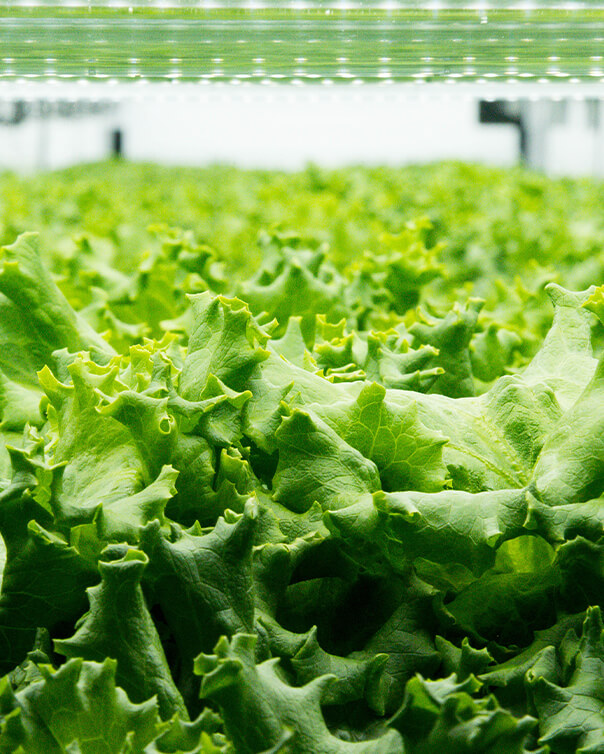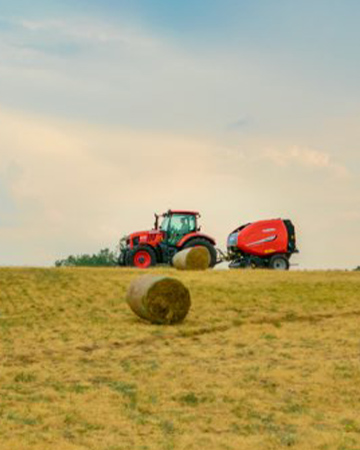
Kubota, which is realizing innovations in smart agriculture, launched a trial experiment in July 2021 to make greenhouse cultivation smarter.
Six companies are taking part in this experiment, including Kubota, KantoKoushin Kubota Corp., and startups located in Japan. Combining solutions utilizing robotics, AI, and other technologies owned by each company, the experiment aims to automate the growing of asparagus, as well as to optimize cultivation through each process by mutually utilizing data collected with various solutions.
In this article, we interview one of the leaders of this experiment at the Kubota Innovation Center, which promotes open innovation, to learn more about the new value that can be created using smart greenhouse cultivation.
The On-Site Needs for Greenhouse Cultivation Sensed by Kubota
Greenhouse cultivation is the practice of growing vegetables, fruits, flowers (ornamental plants), and other crops inside vinyl-sided or glass-sided houses. This offers advantages in that it is less susceptible to weather, temperature, and insects, and it is easier to stabilize yield and quality compared to open field cultivation.
"One of the greatest challenges in achieving stable quality and yield in greenhouse cultivation is harvesting," says Joji Fukaishi of KantoKoushin Kubota Corp., who manages the Orange Farm developed by Kubota, speaking on the example of growing asparagus in greenhouses. "Every day during the May to August harvest season, we have to manually harvest asparagus that have grown to the right length, which is extremely hard work. It is also very difficult to find people who will do the work."

As evidenced here, greenhouse growers are calling for lighter workloads and optimized cultivation. Kubota, which aims to be a total solutions provider for agriculture, is working to address these issues and provide new value by collaborating with startups and other companies on initiatives to realize smart greenhouse cultivation.
Income and Labor Hours per 10 Acres of Greenhouse Vegetable Cultivation
| Gross revenue (1,000 Yen) |
Farm operational expenses (1,000 Yen) |
Income (1,000 Yen) |
Labor hours (1,000 Yen) |
|
|---|---|---|---|---|
| Greenhouse vegetables |
1,136 | 679 | 456 | 345 |
| Open field vegetables |
425 | 252 | 173 | 184 |
| Fruits | 545 | 324 | 221 | 218 |
| Rice | 134 | 113 | 21 | 41 |
Data is from the Ministry of Agriculture, Forestry and Fisheries publication "Situation of Greenhouse Horticulture" (April 2021). Although greenhouse cultivation yields higher gross revenue per unit area compared to open field cultivation, it also requires much more labor hours.
New Methods of Greenhouse Cultivation through Smart Initiatives
What kind of smart greenhouse cultivation does this experiment aim for? We asked Nobuaki Hagimoto of the Kubota Innovation Center’s Business Incubation Department, who heads this initiative.
Three Steps toward Smart Greenhouse Cultivation
What is the background behind your initiatives for smart greenhouse cultivation?
"There are two main reasons. The first is the high dependence on human work in greenhouse cultivation. Compared to rice paddies and other fields, greenhouses require various kinds of tasks when growing large numbers of crops, but there has been little progress in mechanization and automation, leaving much room for improvement in cultivation efficiency. The second is the large number of new farmers trying their hand at greenhouse cultivation. To help farmers who are just starting out continue without too much burden, there are needs for management and efficiency systems that help grow crops more efficiently.”

What kind of management and efficiency system do you hope to establish through this experiment?
“About 97% of the greenhouse growing area in Japan is cultivated using ordinary pipe houses that are not equipped with multifunction environmental control devices. Our goal is to establish a total solution that will enable even these farmers to easily convert their facilities to smart greenhouses, reducing labor in farm work and optimizing overall cultivation.”
What are some of the key factors in realizing smart greenhouse cultivation?
“We believe there are three approaches to smart greenhouse cultivation. The first is automation and labor-saving through implementation of autonomous work robots and other devices. The second is digitizing cultivation information, which makes it possible to share information obtained through the operational records of various sensors, robots, and other sources. The third is the utilization of data between solutions. Through these, we will work to streamline and optimize cultivation. For example, for the watering and fertilization*1 system, which is controlled using soil sensor and other environmental data, we can feed back the data on cultivation outcomes such as yields obtained by harvesting robots, enabling more effective watering and fertilization.”
- *1.Refers to the watering and fertilization of crops.
What are Kubota's initiatives in this project?
“In terms of the approaches for digitizing cultivation information and utilization of data, it is necessary to build a management and efficiency system that can serve as a data exchange platform for sharing data between solutions and giving feedback. Kubota is taking on these roles. Along with the other participating companies, Kubota is working to create an environment where data from the various solutions can be utilized both appropriately and reciprocally.”
To make cultivation smarter, surely the technologies and solutions from startups and other firms will also play a role.
“That's right. There are limits to what Kubota can do alone, so we are working to realize smart greenhouse cultivation by leveraging the strengths of startup firms, research institutions, and others with advanced technologies, and combining these solutions.”

Watering and Fertilization Control System

Monitoring Camera

By collecting and linking various kinds of data from solutions deployed in fields*2, the system improves the accuracy of controls for each solution.
- *2.Fields: Areas of farmland on which crops are raised.
How did you choose the partner companies that are taking part in this experiment?
“We individually approached companies with automation solutions for each process of greenhouse cultivation to participate, and the companies that supported our initiatives have joined us. We made calls to companies that we had worked with in the past as well as new companies.”
Participating Companies and Their Main Roles
| Company name | Main roles |
|---|---|
| Inaho | Automation and efficiency of harvesting work |
| OPTiM | Monitoring of cultivated crops, data analysis, building AI models for estimating growth conditions |
| Routrek Networks | Automation and efficiency of watering and fertilization work, reduction of fertilizer use |
| Legmin | Automation and efficiency of pest control work, reduction of pesticide use |
| KantoKoushin Kubota Corp. | General management of cultivation |
| Kubota | Building environment for mutual data utilization |
How are the participating companies communicating with one another?
“There are practical matters to be discussed, such as how many photos of asparagus to take per second with the cameras set up inside the greenhouses, and we also talk about our vision for the smart cultivation we want to realize in the future, so we communicate almost every day over the phone or email. With our enthusiasm and daily information updates, I can tell that the experiment is proceeding smoothly.”


The experiment is being conducted on the Kubota Incubation Farm. This farm is designed with wider spaces between rows than ordinary fields to allow robots to do their work. This means fewer plants are grown, but by optimizing cultivation, it is expected to yield the same or even more than conventional field layouts. In the first year of cultivation, crops have been densely planted to promote photosynthesis and store nutrients in the stems underground.
Finally, what are your plans for the future?
“To enable a greater number of farmers to experience smart greenhouse cultivation, we hope to work on not just asparagus but also other crops that are produced in large yields. We also believe that there is a need to promote the automation and digitization of farm work in areas that are not currently being addressed. And we would like to explore new partnerships with startups, research institutions, and other parties that have solutions for smarter greenhouse cultivation.”

During our conversation, Mr. Hagimoto gave us another anecdote about a greenhouse farmer working to make his operations smarter. This farmer was very particular about watering and used to adjust the valves manually each day. “I saw how happy he was when he told me, ‘Now that my work is automated, I no longer have to water by myself every day. Recently I went for a trip with my wife for the first time in ages!’ To me, that is what smart farming is all about.” With wishes to contribute to the work and livelihoods of farmers, smart greenhouse cultivation is moving forward step by step. Although their efforts have just begun, the movement to make greenhouses smarter could change how agriculture is done and could eventually become a solution that supports food production in Japan and abroad.



